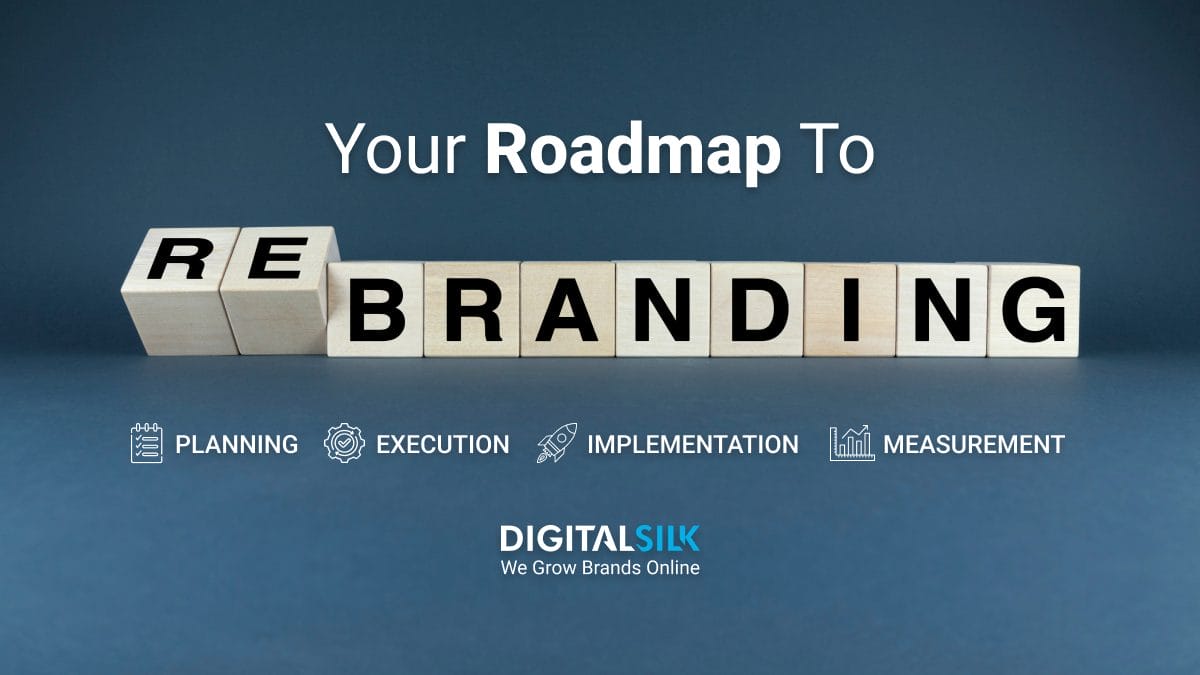Are you looking to increase market share, appeal to a new audience or recover from a brand-damaging crisis?
A rebranding strategy can help you rethink, refresh and reposition your brand as efficiently as possible.
Here, we’ll show you how to create an effective strategy that will help you accomplish your specific rebranding goals. We’ll also provide successful rebranding examples to help get you started.
Digital Silk develops authentic brands. Request a quote
What Is Rebranding?
Rebranding is the process of changing the existing image of a brand.
As a part of your brand management strategy, it can include changes in visual identity, company or product names, key messaging statements, brand values and other elements of an already-established brand.
The purpose of rebranding can vary, but mostly it’s used to refresh the look, adjust the existing image or completely reinvent a brand. Explore some of our case studies and see how rebranding and modern design helped our clients.
If you’ve already established a brand that people trust, it will be easier for you to introduce your company’s new look, style or product lines.
Why?
Because the latest research finds 46% of consumers are willing to pay more for a brand name they trust, up from 30% in 2021.
3 Most Common Types Of Rebranding Strategies
Your rebranding strategy will be closely tied with the purpose of your rebranding campaign and the goals you want to accomplish.
Typically, there are three main types of rebranding strategies:
- Brand refresh strategy to update the brand messaging after a business reorientation or to make the brand more relevant to new markets and new audiences
- Brand merger strategy to merge the brand under a new parent company after a merger or an acquisition
- Brand reinvention strategy to reinvent the brand after a damaging crisis or to overcome a negative business reputation
A strategy can help you roll out a rebrand and ensure your goals are met, whether they include retaining your brand’s legacy in case of a change in market focus or introducing a whole new brand to the market as a response to crisis recovery.
In a nutshell, crafting a rebranding strategy includes:
- Researching (new) markets and audiences
- Setting clear goals and expectations
- Defining the scope of rebranding
- Allocating a rebranding budget
- Creating an action plan
To help you better understand the rebranding process, let’s walk through the key tactics you could use in different rebranding scenarios.
Brand Refresh: How To Rebrand To Reach New Audiences
To make the most of your brand refresh, the best starting point is to research your new target market and a new audience to create a data-backed rebranding strategy. Here’s how to start.
1. Define Your New Audience Personas
If you’re expanding to a new market and targeting a new audience, you need to create new audience personas.
When creating an audience persona, try to be as specific as possible:
- Who is an ideal customer from your new target audience(s)?
- How different are they from your existing customer persona(s)?
- How do they typically interact with products in your category?
- Which of their problems are your products or services going to solve?
- What principles do they passionately defend? What values do they cherish?
- What emotions do you want to evoke when introducing your new brand?
- Which platforms and communication channels are they using the most?
- How can your products or services change their everyday life for the better?
Once you create a persona (or several personas, depending on the scope of your business expansion), you can proceed with the next step – a competitor analysis.
2. Audit Your Competitors For The Defined Market Segments
To evaluate your competitors for new market segments – or completely new markets – the best practice is to start with a classic SWOT analysis.
This will help you assess your competitors in terms of:
- Strengths: What are their strongest points? How can you compete?
- Weaknesses: How can you make their weaknesses work to your advantage?
- Opportunities: Is there a positioning gap you can fill with your unique approach?
- Threats: What are the risks of entering your competitors’ already established space?
Then, you can move on to more specific questions, such as:
- How will you introduce your brand to this new market?
- Where can you reach your audience that your competition can’t?
- What type of campaign would be the best for growing market share?
- Is there anything you don’t know about this new market and competitors?
- Where can you find the answers, so you don’t make any assumptions?
3. Revisit Your Brand Persona, Including Your Archetype, Values, Mission & Vision
To position your brand on new markets, you also need to rethink your brand’s foundation:
- Has the purpose of your brand changed?
- Is your brand archetype still the same?
- Have your mission and vision evolved?
In the case of a brand refresh, you might need to brush up your brand personality and adjust your brand messaging to speak clearly to new audiences. It’s likely you won’t move too far away from your original values, but it’s still a good idea to take a fresh look.
Also, more often than not, your brand archetype won’t change drastically.
For example, if your existing brand is The Caregiver (think UNICEF), it typically isn’t going to become The Outlaw (think Harley Davidson) overnight.
4. Freshen Up Your Brand Voice
Similar to the brand archetype, your brand voice probably won’t change drastically, but you should revisit it and create clear guidelines to make sure it’s used consistently across all channels.
You could choose to add a splash of humor, a slice of sassiness or a dash of healthy rivalry to freshen up the way your brand communicates across channels.
For example, Duolingo is known for its sarcastic tone and humorous Tweets, like this one aimed at Canadian Prime Minister Justin Trudeau:
5. Reimagine Your Visual Identity
Another important step of a brand refresh is the redesign of your brand’s visual identity.
Again, it’s probably not going to be a drastic change or complete reinvention, but rather a minor facelift.
Changes in your visual identity may include:
- A logo redesign
- A light website redesign
- A new color palette
- A new typeface
- Custom illustrations
Once you define your new style, you can apply it to business cards, stationery, marketing collateral, corporate website and other brand elements.
Remember, consistency is key when it comes to your brand’s visual appeal.
6. Brand Refresh Example: Uber
Uber started as a local on-demand transportation company, only to grow into a global network with an extension to food delivery and the logistics industry.
Throughout its brand development, the purpose of the company has remained the same:
“Purpose: Evolve the way the world moves.”
However, since the original mission has been accomplished – “to acquire 40% market share for paid rides in the key U.S. metropolitan markets” – Uber has rephrased its mission and vision statements:
“Mission: Transportation as reliable as running water, everywhere for everyone.”
“Vision: We ignite opportunity by setting the world in motion.”
The current messaging addresses new goals, including those that will come with envisioned Uber Air and Uber Elevate, which will introduce VTOL (vertical take-off and landing) aircrafts.
Uber is clearly growing, but it continues to remain true to its original purpose and keep brand messages relevant to both of its core audience segments – riders and drivers.
Brand Merger: How To Rebrand Following A Merger Or Acquisition
In this case, there are three common outcomes:
- The acquired brand makes small adjustments and quickly integrates with the new environment
- The acquired brand completely changes its identity and blends into the parent company’s brand
- The two (or more) merged brands create a new company
Let’s take a look at the key steps needed to rebrand a company within each of these scenarios.
1. Choose The Right Brand Architecture To Gather Multiple Brands Under One Roof
If your company is growing and you plan to expand your existing brand to include new brands – merged, acquired or internally developed – your strategy should start with choosing the right type of brand architecture.
Brand architecture refers to an organizational structure that consolidates multiple brands under the same umbrella.
It typically includes a master brand (think Google, P&G or Unilever) and brand extensions (sub-brands, co-brands, products or services) developed or acquired by the master brand.
The most common brand architecture models are:
- Branded house: An ever-present master brand is directly linked to sub-brands that may be in different categories but – typically – offering complementary services (e.g., Google)
- House of brands: The master brand may house competing brands in the same category under one roof, but it will nurture the unique identity of each sub-brand (e.g., Unilever)
- Endorsed brands: Sub-brands are developed under the master brand and typically grouped together, but with their own unique brand identity and credibility (e.g., Apple)
Choosing the right type of brand architecture will help you build a cohesive image for your rebranding campaign in the eyes of the public. It will also help your marketing managers make better decisions about the branding strategy and the rebranding rollout tactics.
The rebranding tactics will depend on the brand architecture that fits your company’s situation. They may range from small adjustments to larger ones, such as a name change or a complete reinvention.
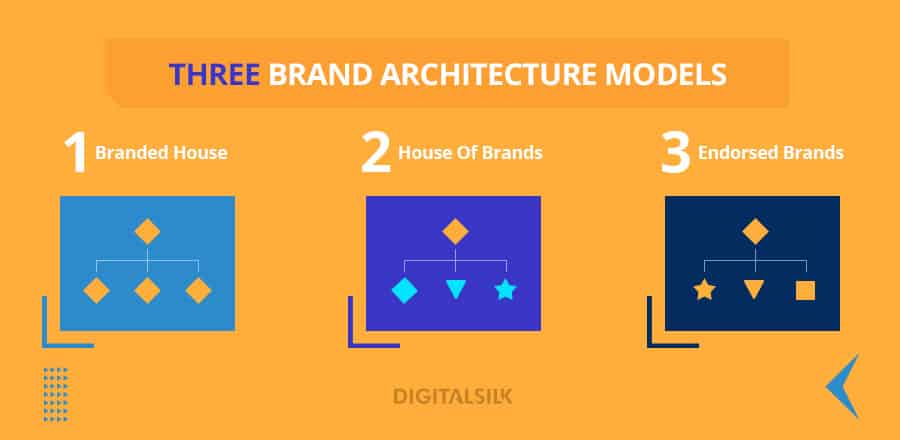
2. Quickly Integrate Your Existing Brand With The New Environment
If your brand has been acquired, the level of your rebranding efforts will highly depend on the previous brand position.
Take Slack for example.
When Salesforce acquired Slack, it was already a successful, well-established brand offering a platform widely used across the world. So, there was no reason for this brand to change its name, visual identity, messaging style or product itself.
The same happened when Adidas acquired Reebok.
Also, when Microsoft acquired LinkedIn.
The acquired brands were already strong on their own, so only a few changes were made during the rebranding process due to acquisition. The changes were mostly at the corporate level, while the public image of the brands remained practically the same.
But what if your company isn’t Slack, LinkedIn or Reebok?
Let’s move on to the rebranding steps you would take if your small business was acquired by a large corporation.
3. Plan A Complex Brand Transition According To The Existing Structure
If your brand is merging or integrating with a large enterprise, it’s up to the parent company to create a brand transition plan for your business.
The best practice is to define the key steps before the acquisition happens.
The rebranding strategy, in this case, may include:
- Creating a branding protocol for the transition
- Choosing the right branding option for the new brand
- Considering the change of the acquired brand’s name
- Aligning the new brand’s visual identity with the existing style
- Including the new brand into the corporate branding efforts
- Coordinating PR and marketing activities around the rollout
Depending on the parent company’s brand architecture or organizational structure, your business may be integrated as a sub-brand, a co-brand, a separate product/service or anything else that fits into the existing portfolio.
In this scenario, your brand’s name, visual identity, messaging, voice, archetype, personality and other elements will likely be unified with the parent company’s existing identity.
4. Brand Merger Example: Novartis
The pharmaceutical company Novartis was created when two brands – Ciba-Geigy and Sandoz – merged in 1996.
The outcome: Ciba-Geigy ceased to exist, while Sandoz became a division of Novartis.
The key rebranding tactics in the case of Sandoz:
- Logo redesign to add “A Novartis Division” to the existing wordmark
- Visual identity makeover to match Novartis’ brand style
- Redesign of print marketing collateral (including business cards, brochures, etc.)
- Adjustment of the brand’s vision, mission and values to be in line with Novartis’
- Rebranding launch plan to announce the merger across media channels
- Repositioning Sandoz as part of a new company, while keeping its legacy relevant
The branding and positioning tactics for the newly created company Novartis, in this case, included creating a brand strategy, style, voice, personality and everything else from the ground up.
Brand Reinvention: How To Rebrand Following A Reputation Crisis
A crisis-driven rebrand has a specific goal to achieve – to rehabilitate a brand in the eyes of the public.
1. Reinvent Your Brand To Create A New Public Image
First and foremost, a rebranding that follows a reputation-damaging crisis has to be genuinely driven by a desire to change the course of the existing brand and reinvent its image.
It has to be authentic.
Otherwise, customers will see through the stunt, which can make them feel disappointed and less likely to support the brand throughout its transition.
The key tactics for this rebranding strategy include:
- Avoid making excuses or denying the impact of a crisis
- Acknowledge the mistakes your company may have made
- Identify the new direction and set the course for a new brand
- Address your existing customers’ concerns during the crisis
- Highlight the issues that need an immediate resolution
- Reconnect with your core brand values
- Consider changing the company name if needed
- Build a new brand by placing customers at the center
- Ensure that everyone on your team is onboard with rebranding
- Create new marketing collateral and prepare to launch campaigns
- Start a rebranding campaign across social media to announce the rebrand
- Issue press releases to set the stage in the public for the new brand to arrive
2. Brand Reinvention Example: Lance Armstrong Foundation
To put this rebranding scenario in perspective, let’s take the Lance Armstrong Foundation for example. This cancer charity was founded by Lance Armstrong, a cancer survivor and seven-time Tour de France winner.
In 2013, when Armstrong admitted to using performance-enhancing drugs during his career, not only was he stripped of all his medals, but he also had to resign from the Foundation’s Board of Directors.
Being so closely tied to its founder, the Foundation tried to disconnect and move away from the negative impact of Armstrong’s confession. The organization immediately changed the name to the Livestrong Foundation.
In the years to come, the foundation has struggled to keep the positive image while remaining relevant to its main audience – cancer patients and their families.
The actual rebranding happened in 2020 when the Livestrong Foundation redesigned its logo and changed the direction.
From the previous focus on one-on-one patient support, the organization has moved towards supporting entrepreneurs who work on the innovation of patient care.
The Most Popular Rebranding Examples To Learn From
You’re probably familiar with some of the brands on this list. You may even remember what they looked like in the past.
It can be helpful to look at the evolution of famous brands to understand how and why rebrands can work to successfully reposition a product, service or company.
1. Chobani
Rebranding strategy: Brand refresh.
What was included in the rebrand?
- Launch of new products
- Packaging redesign
- A shift in brand messaging
- Repositioning the brand
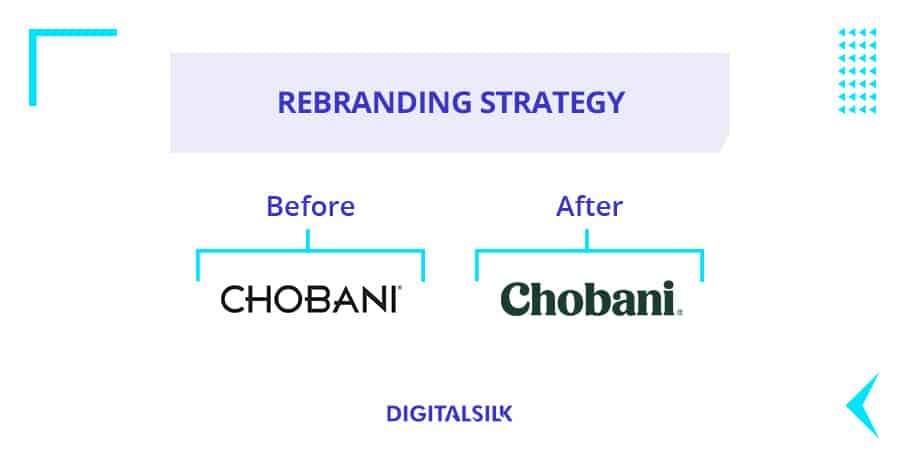

This company needed to rebrand in order to stand out in a competitive yogurt market.
The messaging shifted from a simple yogurt company to a “food-focused wellness company.” They backed this by focusing on nutritional information in their ads and creating new products with less sugar.
Chobani also changed its packaging to more artful designs to help it stand out on the shelves.
2. Dunkin’
Rebranding strategy: Brand refresh.
What was included in the rebrand?
- Change of the company name
- Logo redesign and modernization
- New, modern visual identity
- New messaging to fit market needs
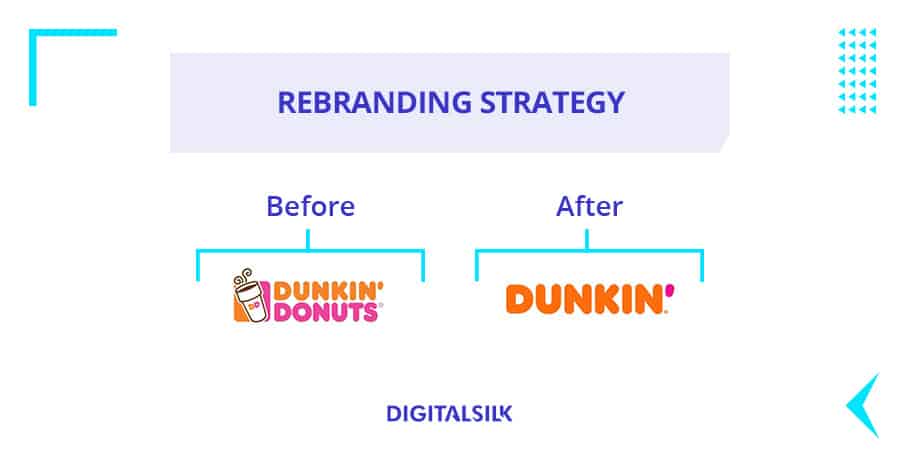
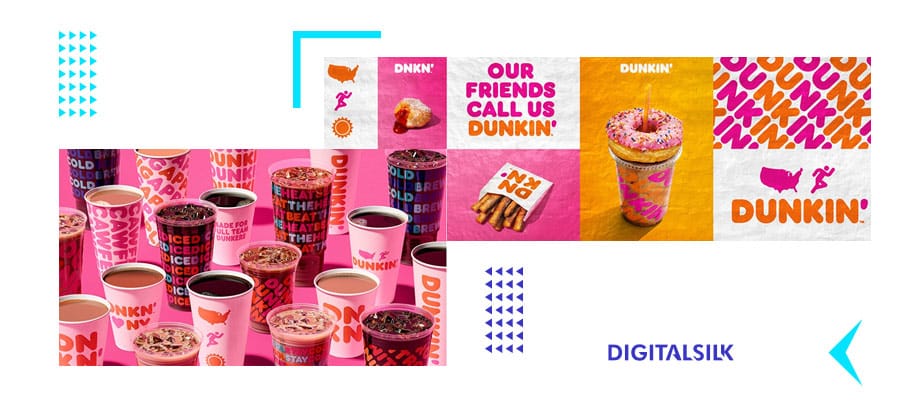
This iconic donut company needed a rebrand to stay current with the market’s needs and audience perception.
With a greater focus on healthy food and coffee consumption at an all-time high, Dunkin’ Donuts dropped the “Donuts” from its name to simplify and modernize the brand.
3. Dropbox
Rebranding strategy: Brand refresh.
What was included in the rebrand?
- Broadening the services
- Repositioning to target a broader market
- Logo refresh to address the change but keep the legacy
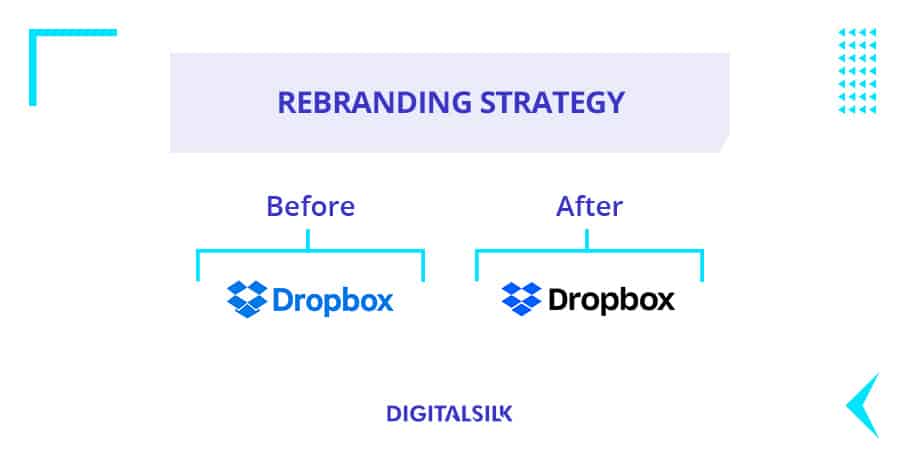
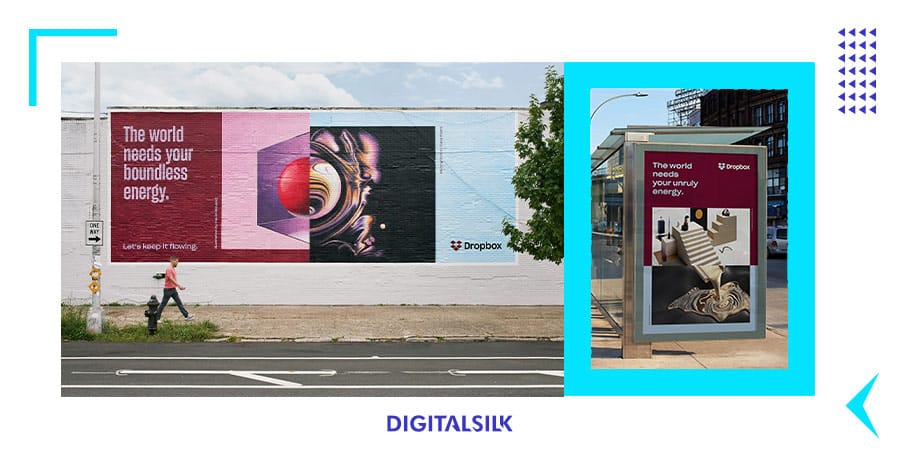
In its 10th year of existence, Dropbox rebranded to signify its evolution from a simple file-sharing service to an open platform and place for creation.
The old logo, which was a literal box, was updated to look more like a collection of platforms but with a nod to its roots.
4. Old Spice
Rebranding strategy: Brand reinvention.
What was included in the rebrand?
- Audience switch from men to women
- Switch from older to the younger audience
- Change of style and brand personality
- A shift in messaging from formal to witty
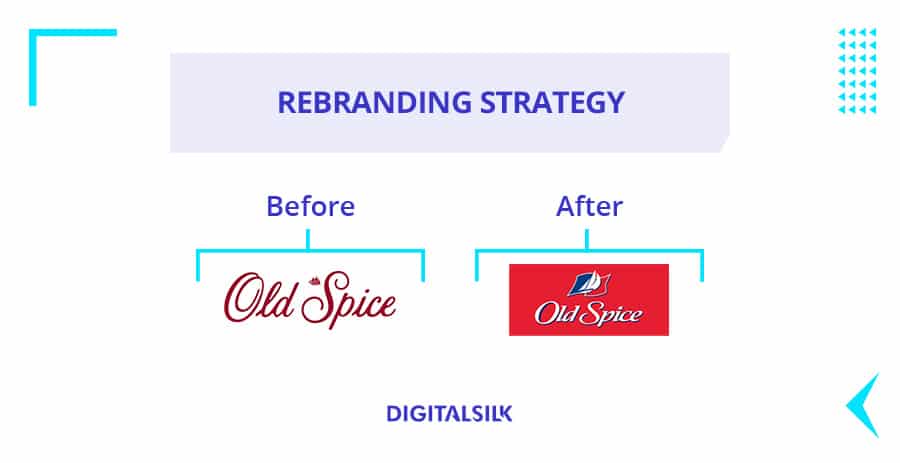
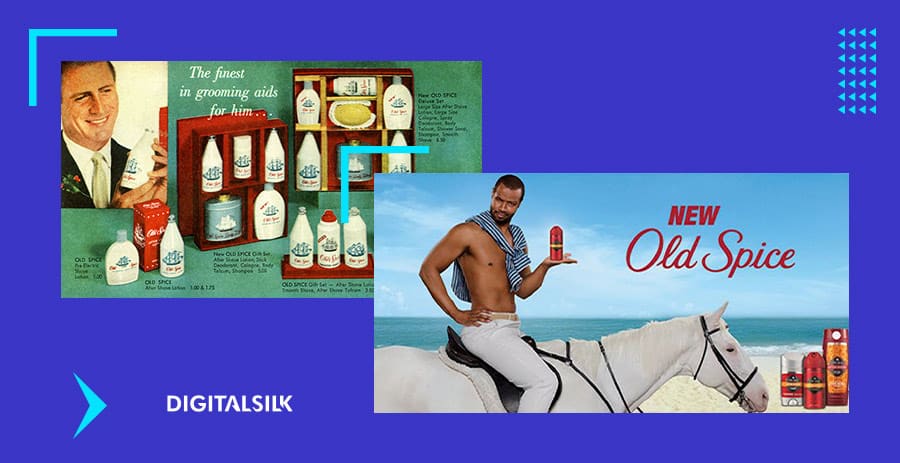
This line of grooming products was originally marketed to women in 1937 as Early American Old Spice.
With few changes over the years, Old Spice came to be seen as old-fashioned, with some referring to it as “your grandfather’s fragrance.”
However, the brand turned the tables when it rebranded with a witty and comedic brand personality that was perceived as young, sexy and fun.
For example, in 2008, the classic shower scene in a commercial was promoted with the slogan “The original. If your grandfather hadn’t worn it, you wouldn’t exist.”
5. CVS Health
Rebranding strategy: Brand reinvention.
What was included in the rebrand?
- Change of the company’s name
- Stronger emphasis on brand values
- Discontinuation of some products
- Complete brand makeover
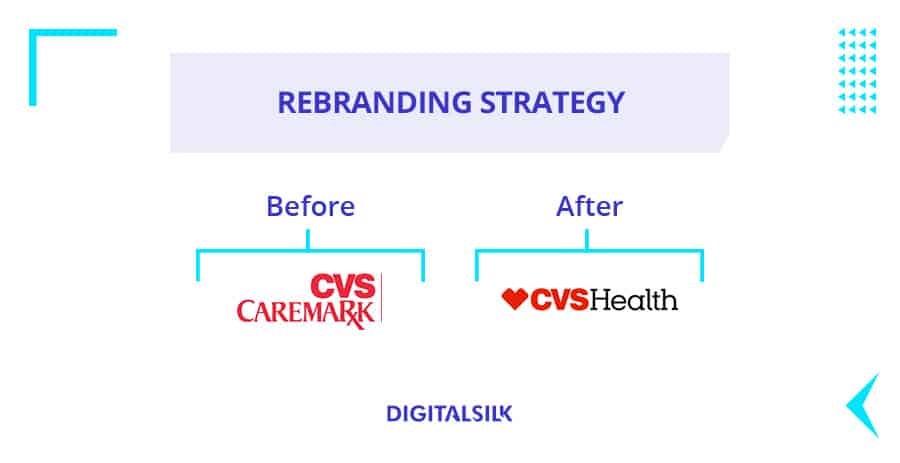
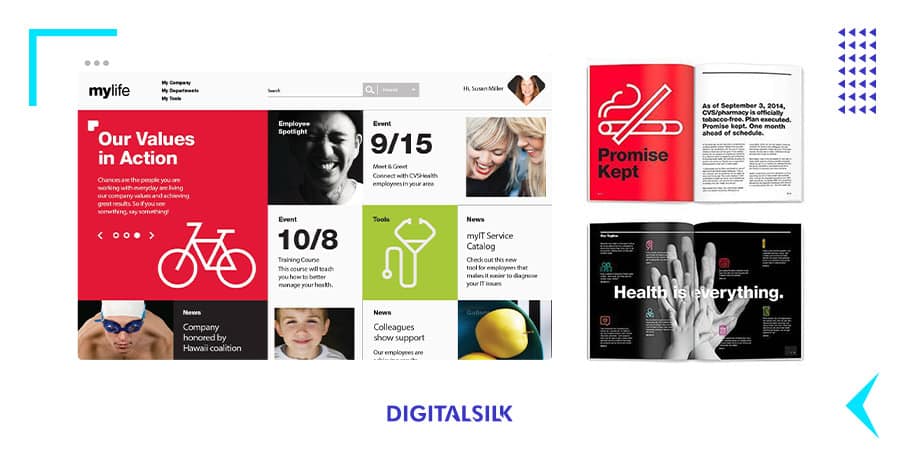
When this pharmaceutical chain rebranded itself from CVS Caremark to CVS Health, it did something to prove that it was truly dedicated to health – it removed all tobacco products from the shelves.
The CVS rebrand shows what it means to put an emphasis on brand values and fully commit to standing by them.
The Best Rebranding Announcement Examples: Google Workspace, Airbnb & Instagram
Announcing a rebrand is never an easy task.
You need to prepare for potentially negative criticism and carefully craft a response. You also need to create a plan for social media announcements, press releases, videos, homepage/website announcements and more.
Let’s take a look at how some of the most famous brands have navigated a rebrand.
1. Google Rebranding Campaign
When Google rebranded G Suite into Google Workspace in October 2020, critics had a mostly negative opinion about it. Not regarding the new brand name or the rebrand itself, but mostly about the logo redesigns. Because, suddenly, all Google app icons looked almost the same.
“Now Gmail is just another rainbow shape in a sea of very similar rainbow shapes,” reported TechCrunch at the time of the rebrand announcement.
However, creating a unified look with recognizable Google colors was a reasonable move from Google’s perspective. As Google announced, the rebrand is going to help their customers to see Workspace “as a product that brings together all the tools they need to get their work done.”
2. Airbnb Rebranding Campaign
Back in 2012, Airbnb’s CEO Brian Chesky hired Pixar animator Nick Sung to make the customer journey storyboards. This helped Airbnb understand its target audience’s challenges – both guests and hosts – and translate them into a brand promise of “transforming how people travel.”
In 2014, it was time for a rebrand to live up to that promise and craft unique messaging that will diversify Airbnb from competitors.
Along with the tagline “Belong Anywhere,” the new Airbnb brand mark Bélo was created as the foundation of the new identity. The idea behind Bélo was to make an icon that encompasses four key points – People, Places, Love and the letter A (representing Airbnb).
The aftermath of the rebrand?
In 2018, Airbnb was evaluated to $29 billion above their closest competitor.
The story today?
After a dip during the COVID-19 pandemic, Airbnb is back to its previous levels of growth. The group posted revenues of $2.5 billion for Q2 of 2023 alone, up 18% from last year.
Watch the video below to see how Airbnb introduced Bélo and the new visual identity.
3. Instagram Rebranding Campaign
“Instagram’s New Logo Is a Travesty. Can We Change It Back? Please?”
This was the headline of the Adweek article published in 2016, at the time of Instagram’s logo and app redesign reveal.
The same article also stated that “it may well go down as one of the biggest design fails of the year”.
Shortly after, millions of Instagram users couldn’t have imagined the app (nor the logo) looking anything different than it looked after the rebrand.
So, what happened there?
Let’s zoom out a bit.
Instagram actually didn’t jump on the bandwagon called flat design at the same time as many other brands did, starting from Apple’s announcement of the iOS7 in 2013.
What Instagram’s lead rebrand designer Ian Spalter did – as he explained in the Abstract: The Art of Design series – was to base the rebrand on understanding “why” of what they were trying to do.
“Instagram knew that it had already evolved from where it started and it was time to signal that the change was coming.”
– Ian Spalter
When Spalter’s team gathered enough data from audience and market research, they decided to declutter and simplify the form, while also following the logo design trends at the time.
When the new look was revealed, critics hit hard, but Instagram’s key performance indicators unveiled different insights. The number of monthly active users grew from 428 million in 2016 to over a billion in 2021 and to 2 billion in 2023.
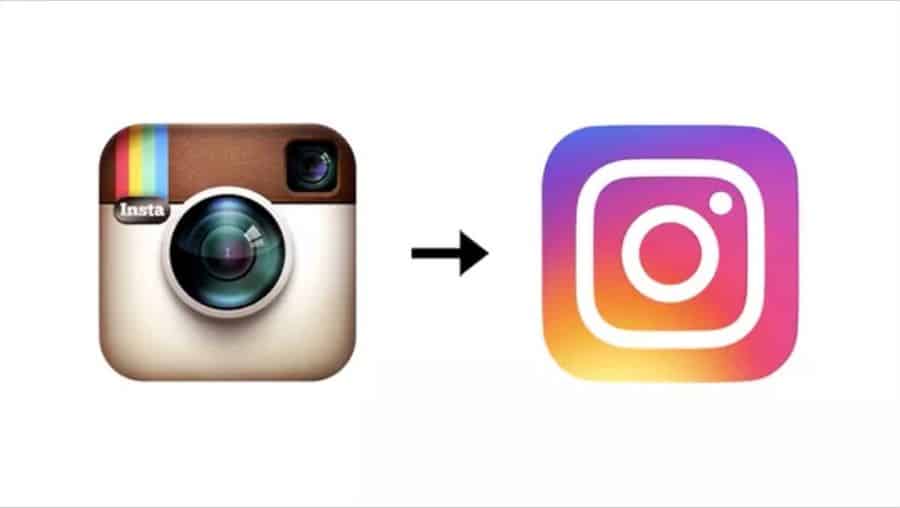
Rebranding Strategy Key Takeaways
When you approach the rebranding process strategically, it enables you to create a roadmap to stimulate new growth, evolve your brand or rehabilitate after a brand-damaging crisis.
When you know the purpose and the main goals of your rebranding campaign, you’ll have a much clearer picture of how to create the most effective strategy for your company.
A rebranding strategy can help you efficiently reposition your company and reintroduce your brand. At Digital Silk, we offer branding services, in addition to web design, development, consulting and more.
Share the details of your project and hear our expert recommendations!
"*" indicates required fields








